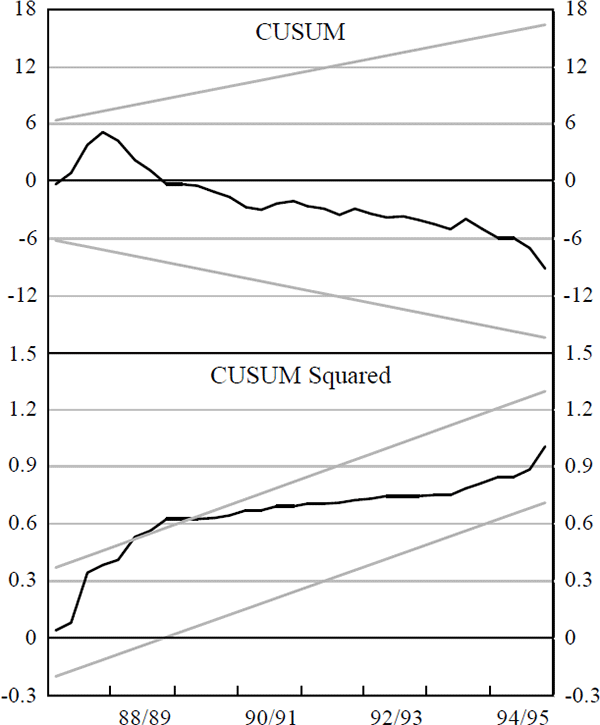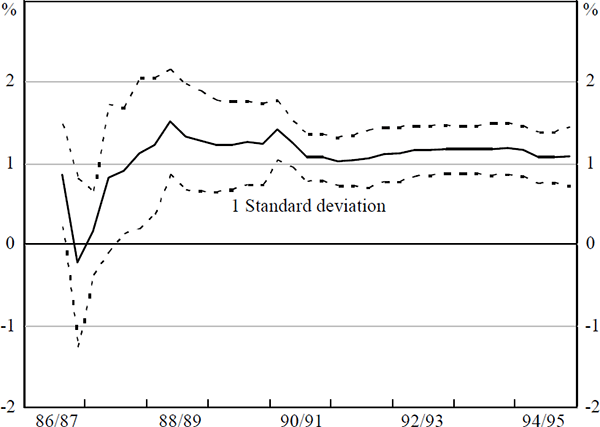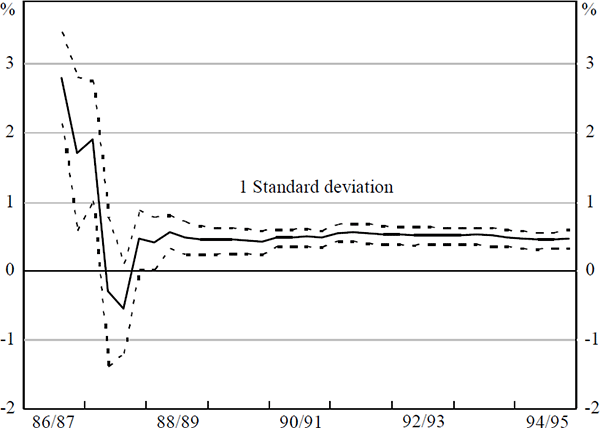RDP 9608: Modelling the Australian Exchange Rate, Long Bond Yield and Inflationary Expectations Appendix B: The Behavioural Model of the Australian Real Exchange Rate – Integration Tests and Diagnostics
November 1996
- Download the Paper 171KB
| Model | Estimated coefficient(a) | |||
|---|---|---|---|---|
| 1985:Q1–1995:Q2 | CCAD | Trend | ||
| Original specification – CCAD | −0.281 | (−2.60*) | ||
| Adding a trend term | 0.626 | (1.49) | −0.012 | (−2.15*) |
| Replacing CCAD with a trend term | −0.004 | (−3.11**) | ||
|
Notes: (a) Estimates are taken from the Bewley Transformation of an unrestricted error correction model. Figures in parenthesis denote t-statistics; * and ** denote significance at the 10% and 5% levels respectively. |
||||
| Sample period | Test-statistic | Significance level | |
|---|---|---|---|
| 1985:Q1–1995:Q2 | 1.06 | F(3,31) | 0.38 |
| 1973:Q4–1995:Q2 | 0.77 | F(3,76) | 0.51 |
| H0: Non-stationarity | H0: Stationarity | ||||||
|---|---|---|---|---|---|---|---|
| Φ3 | ττ | τμ | DF-GLSτ | DF-GLSμ | KPSSτ | KPSSμ | |
| Real exchange rate | 5.48* | −3.31* | −1.77 | −2.92* | −2.03** | 0.05 | 0.78*** |
| Terms of trade | 10.06*** | −4.07*** | −2.86* | −5.67*** | −6.22*** | 0.14* | 0.72** |
| Prices | 8.33** | −2.32 | −3.80*** | 0.62 | 1.68 | 0.25*** | 0.17 |
| Current account | 7.44** | −3.86** | −2.10 | −4.013*** | −3.29*** | 0.13* | 0.58** |
| Debt | 1.76 | −1.87 | −0.26 | −3.18** | 0.03 | 0.09 | 1.06*** |
| Government deficit | 6.97** | −3.71** | −3.31** | −1.99 | −2.12** | 0.08 | 0.23 |
| Yield gap | 5.00 | −3.15* | −3.17** | −4.48*** | −4.11*** | 0.13* | 0.14 |
| Yield gap* | 5.01 | −3.16* | −2.78* | −8.43*** | −8.83*** | 0.05 | 0.26 |
|
Notes: *, ** and *** denote significance at the 10%, 5% and 1% levels respectively. Φ3 refers to the likelihood ratio test of (α, β, ρ)=(α, 0, 1) in Yt = α + βt + ρYt−1 + et. The critical values are from Dickey and Fuller (1981). τ refers to the Augmented Dickey-Fuller (ADF) ‘t-tests’; ττ includes a constant and trend and τμ includes a constant only. The critical values are from Fuller (1976). DF – GLSτ and DF – GLSμ are a modified trend and constant version, respectively, of the ADF tests proposed by Elliot et al. (1992). KPSS is a test proposed by Kwiatkowski et al. (1992) which tests the null hypothesis of stationarity. A truncation lag of 8 is used for the calculation of the estimate of the error variance. |
|||||||
| H0: Non-stationarity | H0: Stationarity | ||||||
|---|---|---|---|---|---|---|---|
| Φ3 | ττ | τμ | DF-GLSτ | DF-GLSμ | KPSSτ | KPSSμ | |
| Real exchange rate | 3.03 | −2.36 | −2.26 | −4.93*** | −2.22** | 0.08 | 0.16 |
| Terms of trade | 8.96** | −4.17*** | −4.24*** | −3.63** | −3.43*** | 0.07 | 0.08 |
| Prices | 6.67* | −1.99 | −3.60*** | −1.14 | 1.12 | 0.17** | 0.61** |
| Current account | 6.13* | −3.43* | −3.37** | −4.78*** | −5.56*** | 0.07 | 0.12 |
| Debt | 11.35*** | −4.74*** | −0.07 | −3.39** | 0.76 | 0.06 | 0.63** |
| Government deficit | 6.61** | −3.31* | −3.23** | −1.27 | −1.55 | 0.15** | 0.15 |
| Yield gap | 6.78** | −3.63** | −2.46 | −5.48*** | −6.14*** | 0.13* | 0.32 |
| Yield gap* | 2.78 | −2.29 | −2.37 | −4.08*** | −5.02*** | 0.13* | 0.13 |
|
Notes: *, ** and *** denote significance at the 10%, 5% and 1% levels respectively. Φ3 refers to the likelihood ratio test of (α, β, ρ)=(α, 0, 1) in Yt = α + βt + ρYt−1 + et. The critical values are from Dickey and Fuller (1981). τ refers to the Augmented Dickey-Fuller (ADF) ‘t-tests’; ττ includes a constant and trend and τμ includes a constant only. The critical values are from Fuller (1976). DF – GLSτ and DF – GLSμ are a modified trend and constant version, respectively, of the ADF tests proposed by Elliot et al. (1992). KPSS is a test proposed by Kwiatkowski et al. (1992) which tests the null hypothesis of stationarity. A truncation lag of 8 is used for the calculation of the estimate of the error variance. |
|||||||
The DF-GLS test (Elliot et al. 1992) is a modified version of the Augmented Dickey-Fuller (ADF) t-test, having the advantages that it exhibits superior power properties and suffers from only small size distortions in finite samples. The testing procedure involves firstly demeaning or detrending the series using Generalised Least Squares and then running the ADF test regression using that series. The constant and time trend terms are omitted from the test regression. The t-statistic on (ρ−1) is then used to test for significance against the appropriate critical value. The demeaned case (DF-GLSμ) is comparable to including a constant term in the ADF test; the critical values are taken from Fuller (1976) and the no-constant variant of the MacKinnon (1991) table. The detrended case (DF-GLSτ) is comparable to including a constant and a time trend in the ADF test; the critical values have been tabulated by Elliot et al.
The KPSS (1992) test is applied in the following way. All series can be written as the sum of a trend (ξt), a random walk (rt), and a stationary component (εt) such that:
If the series is stationary (that is, there is no random walk component), the variance of ut will be zero. The test statistic for the null hypothesis of no unit root is an LM statistic which is a function of estimated residuals and an estimate of the long-run error variance. These residuals are either the demeaned series (ημ) or the demeaned and detrended series (ητ). The critical values for these tests are detailed in Kwiatkowski et al. (1992, p.166).
These tests provide evidence over the full sample period (1973:Q4–1995:Q2) that the real exchange rate; terms of trade; interest differentials; yield gaps; current account deficit; government budget balance; and relative productivity differentials are 1(0), with the first two series exhibiting this stationarity around a trend. These conclusions are also supportable over the shorter sample period (1984:Q1–1995:Q2).
| Interest differential term |
Estimated coefficient |
t-statistic (p-value) |
|
|---|---|---|---|
 |
1.10 |
3.10 |
(0.00) |
 |
0.90 |
2.62 |
(0.01) |
 as per the BW equation. as per the BW equation.
|
1.11 |
1.82 |
(0.08) |
 |
1.81 |
2.47 |
(0.02) |
|
Notes: (a) The real TWI exchange rate model is specified as a function of the
terms of trade; the cumulated current account deficit; an interest differential
term; and a fiscal policy variable. |
|||




